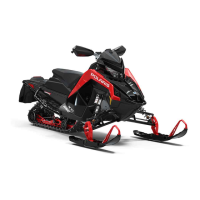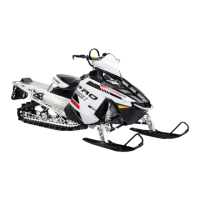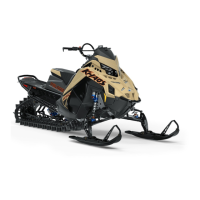2.17
Maintenance
2
PVT SYSTEM
Belt Deflection Inspection
Excessive belt deflection is when the belt is too long or the
center distance is too short. The initial starting ratio will be
too high, resulting in performance loss. This is due to the
belt rising too high in the drive clutch sheaves upon
engagement (A).
Insufficient belt deflection (B) is when
the belt is too short
or the center distance is too long. The initial starting ratio
will be too low. In addition, the machine may creep when
the engine idles, causing damage to the internal face of
the drive belt.
1. Measure the belt deflection with
both clutches at rest
and in their full neutral position.
2. Place a straight edge across the tow clutch
es, on top
the belt.
3. Apply downward pressure to the belt and measure the
di
stance at point (D). Compare to specification.
4. The measurement should be 1-1/4" (3.2cm).
5. If the measurement is not correct, adjust driven clutch.
Team/P2 Deflection Adjustment
1. Verify the drive system is in forward drive.
2. While holding the set screw with an Allen wrench,
lo
osen the jam nut.
3. Turn the set screw clockwise while holding the
jam nut
stationary to increase the distance between the clutch
sheaves (increase belt deflection).
4. Turn the set screw counter-clockwise while holding
the
jam nut stationary to decrease the distance
between the clutch sheaves (decrease belt
deflection).
5. Secure the jam nut while holding the set screw
stationary
.
6. Raise the rear of the snowmobile using a track stand
to allow the
track to spin.
7. Start the engine and apply enough throttle to spin the
track
.
8. Turn off then engine, and repeat belt deflection
in
spection.
Torque Limiter
NOTE: 2010 Models Only
Inspect the rubber dampener for signs of abnormal wear
an
d tear. Adjust the linkage length to specification.
Belt Deflection: 1.25" (3.2cm)
The driven clutch can be damaged if the clutch is in
reverse drive.

